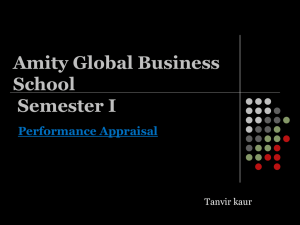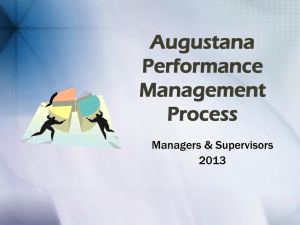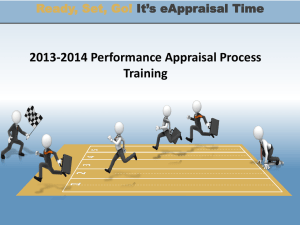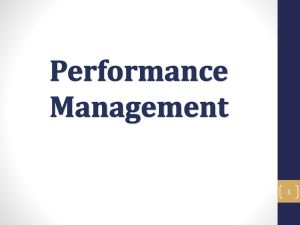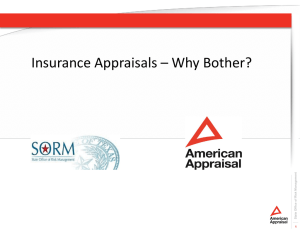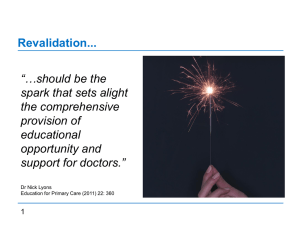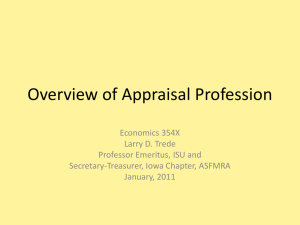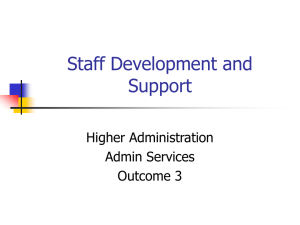continued - Hondros Learning
advertisement
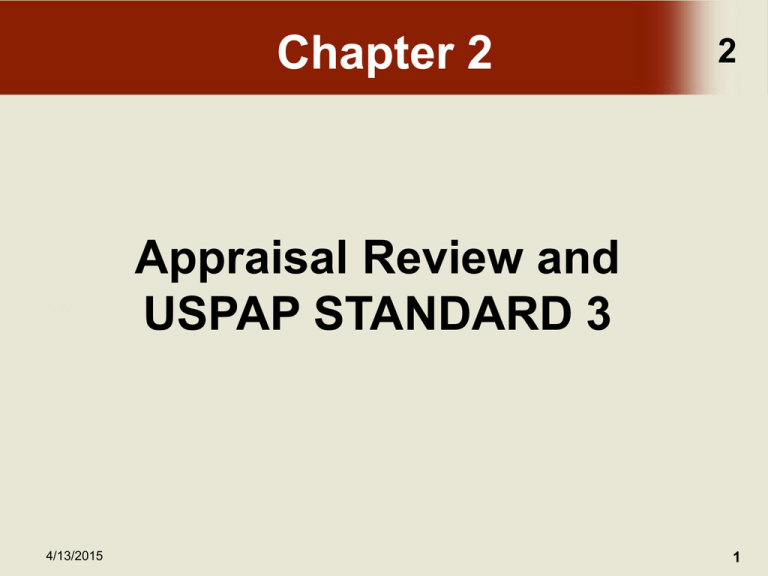
Chapter 2 2 Appraisal Review and USPAP STANDARD 3 4/13/2015 1 Chapter Objectives 2 • Upon completion of this chapter, the participant will be able to: – Discuss guidance of the ASB about appraisal review provided in Advisory Opinion 20. – Describe general competency obligations, including geographic competency and diligence. – Define assignment elements including, intended use, intended users, and purpose. – Discuss identification of relevant characteristics of work under review and scope of work. 4/13/2015 2 Chapter Objectives 2 continued • Upon completion of this chapter, the participant will be able to: – Explain issues related to identifying the effective date in an appraisal review. – Describe when extraordinary assumptions and hypothetical conditions may be used. – Differentiate between reviews that do and do not include reviewer’s own opinions. – Discuss appraisal review report requirements, including certification and report content. 4/13/2015 3 Appraisal Review and STANDARD 3 2 • STANDARD 3 of USPAP is a dualperformance Standard, setting forth the general obligations of an appraiser performing an appraisal review respective to both development and reporting 4/13/2015 4 Introduction to STANDARD 3 2 • Introduction to STANDARD 3: – In developing an appraisal review assignment, an appraiser acting as a reviewer must identify the problem to be solved, determine the scope of work necessary to solve the problem, and correctly complete research and analyses necessary to produce a credible appraisal review. In reporting the results of an appraisal review assignment, an appraiser acting as a reviewer must communicate each analysis, opinion, and conclusion in a manner that is not misleading (USPAP 2012-2013 Edition) – (Bold added for emphasis.) 4/13/2015 5 Introduction to STANDARD 3 2 continued • Comment: – STANDARD 3 is directed toward the substantive aspects of developing a credible opinion of the quality of another appraiser’s work that was performed as part of an appraisal or appraisal review assignment (USPAP 2014-2015 Edition) – Note: The subject of a review assignment most often is the review of an appraisal performed by another appraiser, or its elements. However, STANDARD 3 also applies to a review of all or part of a review assignment 4/13/2015 6 Introduction to STANDARD 3 2 continued • Comment: – STANDARD 3 also addresses the content and level of information required in a report that communicates the results of an appraisal review assignment. STANDARD 3 does not dictate the form, format, or style of Appraisal Review Reports. The substantive content of a report determines its compliance (USPAP 2014-2015 Edition) – Note: The Comment clarifies that STANDARD 3 does not dictate the form, style, or format for a report. Also, there are no reporting options for Appraisal Review Reports, for example, such as those found for Real Property Appraisal Reports. All reports are identified as Appraisal Review Reports 4/13/2015 7 Introduction to STANDARD 3 2 continued • Comment: – In this Standard, the term “reviewer” is used to refer to an appraiser performing an appraisal review (USPAP 2014-2015 Edition) – Note: The Comment clarifies that the term “reviewer” is used within the Standard to identify the appraiser that is performing an appraisal review assignment 4/13/2015 8 Overview of Advisory Opinion 20 2 • Terminology – Appraisal Review - Used in USPAP to identify the activity of a reviewer in an appraisal review assignment – Terms: “review appraisal” and “review appraiser” are specifically and intentionally NOT used within STANDARD 3 to avoid confusion 4/13/2015 9 Examples 2 • The reviewer may develop and report an opinion as to the quality of another appraiser’s work and: – 1. Only state the corrective action to be taken by the appraiser with regard to curing any deficiency, leaving the client to decide whether to interact with the appraiser to accomplish the correction; or – 2. Act on behalf of the client to interact with the appraiser that prepared the original work to ensure any deficiency is appropriately corrected by that appraiser; or – 3. Make corrections to cure an error, such as a mathematical miscalculation, by showing what the calculation would have been if correct but without expressing the result as the reviewer’s own opinion of 4/13/2015 value... 10 Examples 2 • A reviewer may develop and report an opinion as to the quality of another appraiser’s work; and 4. make corrections to cure a deficiency, expressing the result as the reviewer’s own opinion of value, which is to be developed within the same scope of work as was applicable in the assignment that generated the original work; or 5. make corrections to cure a deficiency, expressing the result as the reviewer’s own opinion of value, which is to be developed using a different scope of work than was applicable in the assignment that generated the original work; or 6. regardless of the appraisal review result, develop his or her own opinion of value using the same scope of work as was applicable in the assignment that generated the original work; or 7. regardless of the appraisal review result, develop his or her own opinion of value using a different scope of work than was applicable in the assignment that generated the original work 4/13/2015 11 Standards Rules 2 • STANDARD 3 contains seven Standards Rules – Rules 3-1 to 3-3 address development – Rules 3-4 to 3-7 address reporting 4/13/2015 12 Standards Rule 3-1(a) • 2 Contains requirements consistent with COMPETENCY Rule: – In developing an appraisal review, the reviewer must: (a) be aware of, understand, and correctly employ those methods and techniques that are necessary to produce a credible appraisal review (USPAP 2014-2015 Edition) 4/13/2015 13 Standards Rule 3-1(a) 2 continued • The Comment to Standards Rule 3-1(a) expands on the issue of competency and diligence: – Comment: [Paragraph 1] Changes and developments in economics, finance, law, technology, and society can have a substantial impact on the appraisal profession. To keep abreast of these changes and developments, the appraisal profession is constantly reviewing and revising appraisal methods and techniques and devising new methods and techniques to meet new circumstances. Each appraiser must continuously improve his or her skills to remain proficient in appraisal review (USPAP 2014-2015 Edition) 4/13/2015 14 Standards Rule 3-1(a) 2 continued • Of special interest is the second paragraph of the Comment that discusses geographic competency requirements of the reviewer, which is a much debated current topic: – Comment: [Paragraph 2] The reviewer must have the knowledge and experience needed to identify and perform the scope of work necessary to produce credible assignment results. Aspects of competency for an appraisal review, depending on the review assignment’s scope of work, may include, without limitation, familiarity with the specific type of property or asset, market, geographic area, analytic method, and applicable laws, regulations, and guidelines 4/13/2015 15 Geographic Competency 2 • USPAP Advice – Frequently Asked Question (FAQ): – Q: I have a client who has asked me to perform a desk review on an appraisal report for a property located in a different state. I have no knowledge of the real estate market in that state and have never even stepped foot there. Can I perform a USPAP-compliant appraisal review on this report? 4/13/2015 16 Geographic Competency 2 continued • ASB Response: – Yes. If you are engaged to determine whether or not the appraisal report under review complies with certain guidelines or standards, geographic competence is not typically relevant. Alternatively, review assignments that include evaluating the selection and adjustment of comparable sales typically require geographic competence. As in all assignments, an appraiser must identify the scope of work required for the assignment and determine if he or she has the knowledge and experience to complete the assignment competently 4/13/2015 17 Geographic Competency 2 continued • Example: – A reviewer on the west coast of the country might be able to determine if an appraisal report performed on the east coast is developed and communicated in compliance with USPAP. However, that same reviewer may not be geographically competent to determine if the analysis of market conditions and any resulting market condition adjustments are correct and appropriate 4/13/2015 18 Geographic Competency 2 continued • Some states have specific requirements related to geographic competency while others may not – Recognition of laws and regulations applicable to an assignment is an important step in problem identification 4/13/2015 19 Standards Rule 3-1(b) 2 continued • Standards Rule 3-1(b) is similar to development standards for other appraisal services: – In developing an appraisal review, the reviewer must: (b) not commit a substantial error of omission or commission that significantly affects an appraisal review 4/13/2015 20 Standards Rule 3-1(b) 2 continued • Comment [b]: – A reviewer must use sufficient care to avoid errors that would significantly affect his or her opinions and conclusions. Diligence is required to identify and analyze the factors, conditions, data, and other information that would have a significant effect on the credibility of the assignment results 4/13/2015 21 Standards Rule 3-1(c) 2 • Standards Rule 3-1(c) is similar to development standards for other appraisal services: – In developing an appraisal review, the reviewer must: (c) not render appraisal review services in a careless or negligent manner, such as making a series of errors that, although individually might not significantly affect the results of an appraisal review, in the aggregate affects the credibility of those results 4/13/2015 22 Standards Rule 3-1(c) 2 continued • Comment: – Perfection is impossible to attain, and competence does not require perfection. However, an appraiser must not render appraisal review services in a careless or negligent manner. This Standards Rule requires a reviewer to use due diligence and due care 4/13/2015 23 Standards Rule 3-2 2 • Focuses on the development steps necessary in an appraisal review to: – Identify the problem to be solved – Determine the appropriate scope of work 4/13/2015 24 Assignment Elements 2 • Assignment elements identified in problem identification are: – Client and other intended users – Intended use of the reviewer’s opinions and conclusions – Purpose of the appraisal review – Work under review and its relevant characteristics – Effective date of the reviewer’s opinions and conclusions – Extraordinary assumptions and hypothetical conditions 4/13/2015 25 Intended Users and Intended Use 2 • Standards Rule 3-2(a) and (b) states: – • In developing an appraisal review, the reviewer must: (a) identify the client and other intended users (b) identify the intended use of the reviewer’s opinions and conclusions The term “intended use” refers to the use of the reviewer’s opinions and conclusions by the client and other intended users 4/13/2015 26 Standards Rule 3-2(a) & (b) • 2 Comment: – A reviewer must not: (a)allow the intended use of an assignment or a client’s objectives to cause the assignment results to be biased (b)advocate for a client’s objectives 4/13/2015 27 Intended Use 2 • Examples include but are not limited to: – Quality control – Audit – Qualification – Confirmation 4/13/2015 28 Purpose 2 • Standards Rule 3-2(c) establishes an appraiser’s obligation in identifying the purpose of the appraisal review and indicating whether the appraisal review assignment includes the reviewer developing his own: – Opinion of value – Review opinion 4/13/2015 29 Work Under Review and Relevant Characteristics 2 • Standards Rule 3-2(d) states the reviewer must: – (d) identify the work under review and the characteristics of that work which are relevant to the intended use and purpose of the appraisal review, including: (i) any ownership interest in the property that is the subject of the work under review (ii) the date of the work under review and the effective date of the opinions or conclusions in the work under review (iii) the appraiser(s) who completed the work under review, unless the identity is withheld by the client (iv) the physical, legal, and economic characteristics of the property, properties, property type(s), or market area in the work under review 4/13/2015 30 Overview of Advisory Opinion 20 2 • How Purpose and Intended Use Affect Scope of Work – Section B of the advisory opinion provides examples for when an appraisal review assignment’s scope of work does and for when it does not include the reviewer developing his or her own opinions and conclusions 4/13/2015 31 Examples 2 • The reviewer may develop and report an opinion as to the quality of another appraiser’s work and: – 1. Only state the corrective action to be taken by the appraiser with regard to curing any deficiency, leaving the client to decide whether to interact with the appraiser to accomplish the correction; or – 2. Act on behalf of the client to interact with the appraiser that prepared the original work to ensure any deficiency is appropriately corrected by that appraiser; or – 3. Make corrections to cure an error, such as a mathematical miscalculation, by showing what the calculation would have been if correct but without expressing the result as the reviewer’s own opinion of 4/13/2015 value... 32 Examples 2 • A reviewer may develop and report an opinion as to the quality of another appraiser’s work; and 4. make corrections to cure a deficiency, expressing the result as the reviewer’s own opinion of value, which is to be developed within the same scope of work as was applicable in the assignment that generated the original work; or 5. make corrections to cure a deficiency, expressing the result as the reviewer’s own opinion of value, which is to be developed using a different scope of work than was applicable in the assignment that generated the original work; or 6. regardless of the appraisal review result, develop his or her own opinion of value using the same scope of work as was applicable in the assignment that generated the original work; or 7. regardless of the appraisal review result, develop his or her own opinion of value using a different scope of work than was applicable in the assignment that generated the original work 4/13/2015 33 Effective Date 2 • Standards Rule 3-2(e) requires the reviewer, in developing an appraisal review assignment, to: – (e) identify the effective date of the reviewer’s opinions and conclusions 4/13/2015 34 Extraordinary Assumptions and Hypothetical Conditions 2 • Standards Rules 3-2(f) and 3-2(g) address the obligations regarding extraordinary assumptions and hypothetical conditions in a review assignment • Both Standards Rules are similar to the obligations found in the corresponding development Standard for a real property appraisal 4/13/2015 35 Standards Rule 3-2 (f) 2 • Standards Rule 3-2(f) obligates the reviewer when developing an appraisal review to: – (f) identify any extraordinary assumptions necessary in the review assignment 4/13/2015 36 Standards Rule 3-2 (f) 2 continued • Comment: An extraordinary assumption may be used in a review assignment only if: – it is required to properly develop credible opinions and conclusions – the reviewer has a reasonable basis for the extraordinary assumption – use of the extraordinary assumption results in a credible analysis and – the reviewer complies with the disclosure requirements set forth in USPAP for extraordinary assumptions 4/13/2015 37 Standards Rule 3-2 (g) 2 • Standards Rule 3-2(g) addresses an appraiser’s obligation in an appraisal review assignment to: – (g) identify any hypothetical conditions necessary in the review assignment 4/13/2015 38 Standards Rule 3-2 (g) 2 continued Comment: A hypothetical condition may be used in a review assignment only if: – use of the hypothetical condition is clearly required for legal purposes, for purposes of reasonable analysis, or for purposes of comparison – use of the hypothetical condition results in a credible analysis and – the reviewer complies with the disclosure requirements set forth in USPAP for hypothetical conditions 4/13/2015 39 Extraordinary Assumption 2 • An assumption, directly related to a specific assignment, as of the effective date of the assignment results, which, if found to be false, could alter the appraiser’s opinions or conclusions – Comment: Extraordinary assumptions presume as fact otherwise uncertain information about physical, legal, or economic characteristics of the subject property; or about conditions external to the property, such as market conditions or trends; or about the integrity of data used in an analysis 4/13/2015 40 Extraordinary Assumption 2 continued • The use of an extraordinary assumption is appropriate when the appraiser has a reasonable basis for his belief, but he is not certain • Disclosure of the use of an extraordinary assumption is required 4/13/2015 41 Extraordinary Assumption 2 continued • Comment: Other information that the appraiser could presume as fact, but of which he is uncertain, may include: – Legal or economic characteristics of the subject property – Conditions external to the property, such as market conditions or trends – Integrity of data used in an analysis 4/13/2015 42 Extraordinary Assumption 2 continued • Example – A common application of an extraordinary assumption is in the situation of an exterior-only (drive-by) appraisal. In this case, the appraiser does not inspect the interior of the subject property. If the appraiser has a reasonable basis and credible assignment results can be achieved, an extraordinary assumption may be used to approximate the characteristics of the subject property’s interior 4/13/2015 43 Hypothetical Condition 2 • A condition, directly related to a specific assignment, which is contrary to what is known by the appraiser to exist on the effective date of the assignment results, but is used for the purpose of analysis – Comment: Hypothetical conditions are contrary to known facts about physical, legal, or economic characteristics of the subject property; or about conditions external to the property, such as market conditions or trends; or about the integrity of data used in an analysis 4/13/2015 44 Hypothetical Condition 2 continued • With a hypothetical condition, on the other hand, the appraiser knows that related circumstances or data being considered about the property are not true • Circumstances warranting the use of a hypothetical condition may be best described as “what if” situations 4/13/2015 45 Hypothetical Condition 2 continued • With a hypothetical condition, the appraiser is aware that the circumstances of how the property is being considered are not what actually existed on the effective date of the appraisal 4/13/2015 46 Hypothetical Condition 2 continued • Example – When an appraisal is performed for a proposed new construction with a current effective date. In this case, the appraiser is fully aware that on the current effective date, the structure is not yet built (hypothetical), but the appraiser completes the appraisal as if it were fully constructed (true). Hypothetical conditions must be prominently disclosed in the report, alerting the client and intended users that the circumstances considered were not actually present on the effective date 4/13/2015 47 Hypothetical Condition 2 continued • Other examples include: – Appraising a property “as-repaired” that has not been repaired on the effective date – Considering a completed addition to a property that has not been started on the effective date – Appraising a property with different zoning than exists on the effective date – Appraising a property that has environmental issues and considering that those the issues have been corrected on the effective date 4/13/2015 48 Standards Rule 3-2 (h) 2 • Standards Rule 3-2(h) reflects the obligations found in the SCOPE OF WORK RULE • In developing an appraisal review, the reviewer must : – (h) determine the scope of work necessary to produce credible assignment results in accordance with the SCOPE OF WORK RULE 4/13/2015 49 Standards Rule 3-2 (h) 2 continued • Comment: Reviewers have broad flexibility and significant responsibility in determining the appropriate scope of work in an appraisal review assignment – Information that should have been considered by the original appraiser can be used by the reviewer in developing an opinion as to the quality of the work under review – Information that was not available to the original appraiser in the normal course of business may also be used by the reviewer; however, the reviewer must not use such information in the reviewer’s development of an opinion as to the quality of the work under review 4/13/2015 50 Standards Rule 3-2 (h) 2 continued • Note: – The original appraiser cannot be discredited if information that was not available in the normal course of business at the time of the original appraisal was not used 4/13/2015 51 Standards Rule 3-3 2 • Standards Rule 3-3 addresses an appraiser’s obligation to “apply appraisal review methods and techniques that are necessary for credible results” – In developing an appraisal review, a reviewer must apply the appraisal review methods and techniques that are necessary for credible assignment results (USPAP 2012-2013 Edition) 4/13/2015 52 Standards Rule 3-3(a) 2 • Standards Rule 3-3(a) elaborates on specific development requirements when performing an appraisal review: – (a) When necessary for credible assignment results in the review of analyses, opinions, and conclusions, the reviewer must: (i) develop an opinion as to whether the analyses are appropriate within the context of the requirements applicable to that work (ii) develop an opinion as to whether the opinions and conclusions are credible within the context of the requirements applicable to that work and (iii) develop the reasons for any disagreement (USPAP 2012-2013 Edition) 4/13/2015 53 Standards Rule 3-3(a) 2 continued • The Comment to Standards Rule 3-3(a) expands on the specific elements of examination that a review appraiser is developing regarding the work he is reviewing: – Comment: Consistent with the reviewer’s scope of work, the reviewer is required to develop an opinion as to the completeness, accuracy, adequacy, relevance, and reasonableness of the analysis in the work under review, given law, regulations, or intended user requirements applicable to the work under review (USPAP 2012-2013 Edition) 4/13/2015 54 Standards Rule 3-3(b) 2 • Standards Rule 3-3(b) describes development requirements when reviewing a report • The Comment to Standards Rule 3-3(a) expands on the specific elements of examination that a review appraiser is developing regarding the work he is reviewing 4/13/2015 55 Standards Rule 3-3(c) 2 • Standards Rule 3-3(c) discusses the development requirements that apply when a reviewer provides his or her own opinion of value or review opinion • The Comment to Standards Rule 3-3(c) indicates what services the requirements apply to 4/13/2015 56 Overview of Advisory Opinion 20 2 • Scope of Work and the Reviewer’s Opinion of Value – Emphasizes that whenever the assignment requires the reviewer to develop his own value opinion, the scope of work in the assignment is expanded – Explains the obligation for the reviewer to develop his own value opinion in compliance with the appropriate development standard 4/13/2015 57 Extraordinary Assumption 2 • Section C of AO-20 also specifies that: – In cases where the reviewer uses items from the work under review that he has concluded are credible and in compliance with the applicable development standard, when developing his own value opinion, he is basing such use on an extraordinary assumption 4/13/2015 58 Altering Scope of Work 2 • Section C of AO-20 clarifies that: – The scope of work in a review assignment may be different than the scope of work in the original appraisal • If the scope of work is different in the review assignment, or if the reviewer is using different information that was not available or not used by the appraiser in the original assignment, the appraisal results could also be different 4/13/2015 59 Altering Scope of Work 2 continued • Another key point in Section C of AO-20 is: – Any information used by the reviewer that was unavailable to the original appraiser must not be used as a basis to discredit the original appraiser’s value opinion 4/13/2015 60 Altering Scope of Work 2 continued • Section C of AO-20 includes this advice: – When the original appraiser’s and the reviewer’s value opinions differ, the reviewer must be careful to correctly identify the cause of the difference during the appraisal review process – If the reviewer is incorrect in characterizing the cause of any deficiency found in the original work, diminished credibility could result regarding both the review conclusions and the value opinion expressed by the reviewer 4/13/2015 61 Standards Rule 3-4 2 • Standards 3-4 presents general requirements for reporting that apply to an appraisal review assignment: – Each written or oral Appraisal Review Report must be separate from the work under review and must: (a) clearly and accurately set forth the appraisal review in a manner that will not be misleading (b) contain sufficient information to enable the intended users of the appraisal review to understand the report properly and (c) clearly and accurately disclose all assumptions, extraordinary assumptions, hypothetical conditions, and limiting conditions used in the assignment 4/13/2015 62 Standards Rule 3-4 2 continued • The Comment to Standards Rule 3-4 clarifies the purpose of an Appraisal Review Report and elaborates that the report level and content is specific to the needs of the client and intended users, the intended use, and other requirements applicable to the assignment 4/13/2015 63 Standards Rule 3-5 2 • Standards Rule 3-5 expands on the requirements of the minimum report content that is similar to the reporting requirements of other Standards 4/13/2015 64 Standards Rule 3-5 (d) 2 • Standards Rule 3-5 (d) discusses the obligation of the reviewer to identify in the Appraisal Review Report at a minimum: – The work under review – The date of the work under review – The effective date of the opinions or conclusions in the work under review – The appraisers who completed the work under review (unless identity withheld by client) which must be stated in report if applicable 4/13/2015 65 Standards Rule 3-5 (g) 2 • Most of Standards Rule 3-5(e)-(g) is similar to the reporting obligations found in STANDARD 2 for a real property appraisal report: – The reviewer must state the extent of any significant assistance (when applicable) in the appraisal review report 4/13/2015 66 Standards Rule 3-5 (h) 2 • Standards Rule 3-5(h) amplifies the level of reporting of the reviewer’s opinions and conclusions and the accompanying commentary, which must be included • The Comment indicates: – The report must provide sufficient information to enable the client and intended users to understand the rationale for the reviewer’s opinions and conclusions 4/13/2015 67 Standards Rule 3-5 (j) 2 • Standards Rule 3-5(j) is applicable whenever the scope of work in the review assignment includes the reviewer’s development of his own value opinion or review opinion • Keep in mind: Data and analyses provided by the reviewer’s conclusion must match minimum, reporting requirements 4/13/2015 68 Overview of Advisory Opinion 20 2 • (D) Appraisal Review Report Content – Presents illustrations of various examples of Appraisal Review Report content – The reviewer’s options can significantly vary based on the purpose of the review and the intended use in the review assignment 4/13/2015 69 Reviewer’s Own Opinions 2 • Key points in Section D of A0-20 include: – A reviewer should carefully compose the particular language stating his or her opinions and conclusions to avoid misleading the user of the Appraisal Review Report as to the scope of work completed in the assignment and the meaning of the reviewer’s stated opinions and conclusions – A reviewer must note any additional information relied upon 4/13/2015 70 Reviewer’s Own Opinions 2 continued • Key points in Section D of A0-20 include: – The reasoning and basis for the reviewer’s opinion of value must be summarized, in contrast to the other requirements in this section that must only be stated – Changes to the report content by the reviewer to support a different value conclusion must match, at a minimum, the reporting requirements for an Appraisal Report, when the subject of a review is a real property appraisal 4/13/2015 71 Opinions of Appraiser’s Work 2 • Section D of AO-20 provides an illustration of sample language that may be used when the scope of work in the review assignment is only to develop an opinion of the quality of another appraiser’s work. • Review report content must include: – 1. The information set forth in Standards Rules 35(a)–(h) and – 2. The reviewer’s certification shown in Standards Rule 3-6 4/13/2015 72 Opinions of Appraiser’s Work 2 continued • When the scope of work does not include the reviewer developing his own value opinion, the reviewer must be cautious to avoid implication that the reviewer did develop an opinion of value for the subject property of the original work 4/13/2015 73 Opinions of Appraiser’s Work 2 continued • Examples of proper language used in an Appraisal Review Report that does NOT express an opinion of value include: – “The value opinion stated in the appraisal report is (or is not) adequately supported” – “The value conclusion is (or is not) appropriate and reasonable given the data and analyses presented” Note that the preceding language relates only to the quality of another appraiser’s work and does not imply either an agreement or disagreement with the value opinion by the reviewer. 4/13/2015 74 Opinions of Appraiser’s Work 2 continued • Examples of proper language used in an Appraisal Review Report that does NOT express an opinion of value include: – “The value opinion stated in the report under review was (or was not) developed in compliance with applicable standards and requirements” Note that the preceding language relates only to the quality of another appraiser’s work and does not imply either an agreement or disagreement with the value opinion by the reviewer. 4/13/2015 75 Opinions of Appraiser’s Work 2 continued • Examples of proper language used in an Appraisal Review Report that does NOT express an opinion of value include: – “The content, analyses, and conclusions stated in the report under review are (or are not) in compliance with applicable standards and requirements” Note that the preceding language relates only to the quality of another appraiser’s work and does not imply either an agreement or disagreement with the value opinion by the reviewer. 4/13/2015 76 Opinions of Appraiser’s Work 2 continued • Examples of proper language used in an Appraisal Review Report that does NOT express an opinion of value include: – “I reject the value conclusion as lacking credibility due to the errors and/or inconsistencies found” Note that the preceding language relates only to the quality of another appraiser’s work and does not imply either an agreement or disagreement with the value opinion by the reviewer. 4/13/2015 77 Opinions of Appraiser’s Work 2 continued • Examples of proper language used in an Appraisal Review Report that does NOT express an opinion of value include: – “The value conclusion is not appropriate due to (for example) a significant math error in the Sales Comparison Approach—if calculated properly, the value conclusion would change to $XXX; however, the reader is cautioned that this solely represents a recalculation and not a different opinion of value by the reviewer” Note that the preceding language relates only to the quality of another appraiser’s work and does not imply either an agreement or disagreement with the value opinion by the reviewer. 4/13/2015 78 Opinions of Appraiser’s Work 2 continued • Examples of proper language used in an Appraisal Review Report that does not express an opinion of value include: – “I accept (or approve) the appraisal report for use by XYZ bank (or agency)” Note that the preceding language relates only to the quality of another appraiser’s work and does not imply either an agreement or disagreement with the value opinion by the reviewer. 4/13/2015 79 Reviewer’s Own Opinions 2 • Section D of AO-20 provides illustration of sample language that may be used when the reviewer’s scope of work includes developing his own opinions and conclusions: – The reviewer is not required to duplicate items from the original work – The reviewer can incorporate portions of the original work through use of an extraordinary assumption 4/13/2015 80 Reviewer’s Own Opinions 2 continued • Examples that signify a value opinion offered by the reviewer: – “I concur (or do not concur) with the value” – “I agree (or disagree) with the value” – “In my opinion, the value is (the same)” Note that these examples DO constitute evidence of a value opinion (i.e., appraisal) by the reviewer; thereby making the appraisal review one that includes an appraisal 4/13/2015 81 Reviewer’s Own Opinions 2 continued • Examples that signify a value opinion offered by the reviewer: – “In my opinion, the value is incorrect and should be $XXX” – “In my opinion, the value is too high (or too low)” Note that these examples DO constitute evidence of a value opinion (i.e., appraisal) by the reviewer; thereby making the appraisal review one that includes an appraisal 4/13/2015 82 Reviewer’s Own Opinions 2 continued • Note: – In Section D of AO-20, the ASB makes a point of emphasizing that the preceding language (or language that is similar) implies that the reviewer has taken the appropriate development steps in forming his own value opinion – The advice goes on to caution that if the reviewer is rejecting the value opinion found in the original work, that the reviewer must be careful about how that result is stated 4/13/2015 83 Reviewer’s Own Opinions 2 continued • If the reviewer’s rejection of the value opinion is based on errors or inconsistencies found in the work, but the review commentary does not indicate whether the reviewer’s perception of value is lower or higher than the original, no value opinion has been provided by the reviewer • If the rejection is stated in relation to a value (lower, higher, etc.), the commentary indicates that the review process also includes an appraisal by the reviewer 4/13/2015 84 Standards Rule 3-6 2 • Standards Rule 3-6 presents the certification requirements for an Appraisal Review Report (similar to the certification requirements found in STANDARD 2 for a real property appraisal report) • The Comment to Standards Rule 3-6 specifically warns that an appraisal review is a completely different activity than cosigning a report, such as when a supervisory appraiser cosigns with a trainee 4/13/2015 85 Appraisal Report Content 2 • Section D of AO-20 provides a list of summarized fundamental requirements when the scope of work in the appraisal review assignment includes the reviewer expressing his own opinion of value 4/13/2015 86 Standards Rule 3-7 2 • Standards Rule 3-7 covers the requirements for an oral Appraisal Review Report • The most common use of an oral Appraisal Review Report is when the reviewer is communicating the results of an appraisal review during court testimony • The Comment to Standards Rule 3-7 refers to the corresponding requirements of the RECORD KEEPING RULE 4/13/2015 87 Chapter 2 Quiz 2 1. Standards Rule 3-1 contains language regarding a. b. c. d. 4/13/2015 assignment elements. basic requirements for competency. reviewers who provide their own opinion(s). work under review and its relevant characteristics. 88 Chapter 2 Quiz 2 2. In developing an appraisal review, the reviewer identifies the work under review and the characteristics of that work (relevant to its intended use and purpose). What information should the reviewer NOT include when developing an appraisal review? a. any ownership interest in the property b. credentials of the appraiser in the work under review c. date of work under review and effective date of opinions d. physical, legal, and economic characteristics of the property 4/13/2015 89 Chapter 2 Quiz 2 3. Standards Rule 3-2 identifies numerous assignment elements for an appraisal review assignment. Which is NOT one of those elements? a. client and other intended users b. effective date of the review c. extraordinary assumptions and hypothetical conditions d. minimum report content 4/13/2015 90 Chapter 2 Quiz 2 4. During an appraisal review assignment, the reviewer included an extraordinary assumption. What could be the reason for this? a. disclosure of an extraordinary assumption is required by law b. an extraordinary assumption is necessary for purposes of comparison c. there is a reasonable basis for the extraordinary assumption d. use of an extraordinary assumption is always required 4/13/2015 by USPAP 91 Chapter 2 Quiz 2 5. A reviewer is reviewing the analyses, opinions, and conclusions of an appraisal report. During this process, the reviewer disagrees with some of the analyses. What must she do? a. decide whether the issues discovered are worthy of reporting b. describe the faults of the appraiser who produced the work under review c. develop reasons for any disagreement d. obtain client approval to report the disagreements 4/13/2015 92 Chapter 2 Quiz 2 6. In the course of an appraisal review assignment, the reviewer is developing her own opinion of value in an appraisal review; thus, she must develop that opinion in compliance with the __________ applicable to the development of her opinion. a. b. c. d. 4/13/2015 Guideline Provision Regulation Standard 93 Chapter 2 Quiz 2 7. Standards Rule 3-4 covers the __________ requirements that apply to an appraisal review assignment. a. b. c. d. 4/13/2015 certification general reporting maximum reporting specific development 94 Chapter 2 Quiz 2 8. According to Standards Rule 3-5(d), under what circumstance must a reviewer identify the appraiser's) who performed the work being reviewed in the Appraisal Review Report? a. always, unless the identity is withheld by the client b. only when an appraisal review is being performed for a federal entity c. never, as this would violate confidentiality d. whenever the appraiser’s identity is determined vital in the scope of work 4/13/2015 95 Chapter 2 Quiz 2 9. The content of an Appraisal Review Report must be consistent with the a. intended use of the appraisal review. b. level of content found in the work being reviewed. c. requirements for a Restricted Use Report. d. scope of work in the assignment. 4/13/2015 96 Chapter 2 Quiz 2 10. Data and analysis provided by the reviewer to support a different opinion or conclusion in an appraisal review of a real property appraisal must match, at a minimum, the reporting requirements for a(n) ________ Report. a. b. c. d. 4/13/2015 Appraisal Appraisal Review Business Appraisal Restricted Appraisal 97 Chapter 2 Quiz 2 11. A co-reviewer in an appraisal review assignment has signed the certification for an Appraisal Review Report along with another coreviewer. This means that each co-reviewer accepts responsibility for the assignment results and contents of the report, as well as a. all elements of the certification. b. the elements of the certification that pertain to his contributions. c. the general requirements of the report. d. only the elements that he specifically indicates in the report. 4/13/2015 98 Chapter 2 Quiz 2 12. A reviewer is performing an appraisal review of a real property appraisal that includes expressing whether he agrees or disagrees with the value opinion found in the appraisal report he is reviewing. Which Standard would apply to the development of his conclusions regarding the value opinion. a. b. c. d. 4/13/2015 STANDARD 1 STANDARD 2 STANDARD 3 STANDARD 4 99 Chapter 2 Quiz 2 13. In an appraisal review assignment in which the scope of work does NOT include the reviewer developing his own opinion of value, the effective date is a. determined by the appraiser based upon the intended use. b. the date the appraisal review assignment was completed. c. left to the discretion of the client. d. the same as the effective date of the work being reviewed. 4/13/2015 100 Chapter 2 Quiz 2 14. In compliance with USPAP, use of a hypothetical condition in an appraisal review assignment requires a. b. c. d. 4/13/2015 an additional certification statement. disclosure in the report. a prospective effective date. use of a jurisdictional exception. 101 Chapter 2 Quiz 2 15. A reviewer may not discredit the original appraiser for not using data that was not available at the time of the original assignment if the a. data was not available to the original appraiser in the normal course of business. b. original appraiser’s value opinion is still credible. c. review assignment is not being completed for regulatory use. d. use of a hypothetical condition was necessary in the assignment. 4/13/2015 102
